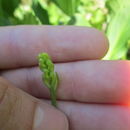Comments
provided by eFloras
In common with Platanthera nivea and P. integra, the column of P. clavellata bears a series of lateral projections that are directed forward; the upper pair is elaborately adorned and may be glandular. It appears that this species is inappropriately placed in Platanthera. See note under 30. P. nivea.
The broader leaves cited as distinguishing Platanthera clavellata var. ophioglossoides are more prevalent in the North, but occur throughout the range of the species. In some areas populations commonly display a complete range of leaf shape; this feature alone is of no taxonomic significance.
The unusual and infrequent hybrid Platanthera blephariglottis × P. clavellata is P. × vossii Case.
- license
- cc-by-nc-sa-3.0
- copyright
- Missouri Botanical Garden, 4344 Shaw Boulevard, St. Louis, MO, 63110 USA
Description
provided by eFloras
Plants 8–47 cm. Leaves 1(–2), on basal half of stem, ascending to spreading, usually abruptly reduced to bracts distally; blade oblanceolate to oblong, linear-oblong, or elliptic, 3–19 × 0.8–3.5 cm. Spikes moderately dense. Flowers resupinate, often incompletely so and held at angle, not showy, rather inconspicuous pale green to dull yellowish green; lateral sepals porrect; petals ovate to obovate; lip oblong, obscurely 3-lobed, without basal thickening, 3–7 × 3–4 mm, margins sometimes dentate-lacerate, apex truncate; spur clavate, 7–13 mm; rostellum lobes directed downward, very short, truncate; pollinaria straight or slightly curved laterally; pollinia fragmenting, pollen masses trailing down onto stigma; viscidia linear to linear lanceolate; ovary rather stout, 6–11 mm. 2n = 42.
- license
- cc-by-nc-sa-3.0
- copyright
- Missouri Botanical Garden, 4344 Shaw Boulevard, St. Louis, MO, 63110 USA
Distribution
provided by eFloras
N.B., Nfld. and Labr. (Nfld.), N.S., Ont., P.E.I., Que.; Ala., Ark., Conn., Del., D.C., Fla., Ga., Ill., Ind., Iowa, Ky., La., Maine, Md., Mass., Mich., Minn., Miss., N.H., N.J., N.Y., N.C., Ohio, Okla., Pa., R.I., S.C., Tenn., Tex., Vt., Va., W.Va., Wis.
- license
- cc-by-nc-sa-3.0
- copyright
- Missouri Botanical Garden, 4344 Shaw Boulevard, St. Louis, MO, 63110 USA
Flowering/Fruiting
provided by eFloras
Flowering summer (Jun--Aug).
- license
- cc-by-nc-sa-3.0
- copyright
- Missouri Botanical Garden, 4344 Shaw Boulevard, St. Louis, MO, 63110 USA
Habitat
provided by eFloras
Sphagnum bogs, sphagnous seeps and meadows, wet sandy and peaty meadows, marshes, low woods, wet prairies, and roadsides; 0--2000m.
- license
- cc-by-nc-sa-3.0
- copyright
- Missouri Botanical Garden, 4344 Shaw Boulevard, St. Louis, MO, 63110 USA
Synonym
provided by eFloras
Orchis clavellata Michaux, Fl. Bor.-Amer. 2: 155. 1803; Habenaria clavellata (Michaux) Sprengel; H. clavellata var. ophioglossoides Fernald
- license
- cc-by-nc-sa-3.0
- copyright
- Missouri Botanical Garden, 4344 Shaw Boulevard, St. Louis, MO, 63110 USA
Platanthera clavellata
provided by wikipedia EN
Platanthera clavellata, commonly known as the club-spur orchid or small green wood orchid,[1] is a terrestrial orchid of North America.
Description

Illustration of
Platanthera clavellata (left, numbered 4/5/6) and
Platanthera nivea (right)
Platanthera clavellata plants are 4-16" tall. It is one of the smallest species out of the 32 species of Platanthera common in North America.[2] The stem has several leaves attached of which all but the bottom-most one are greatly reduced in size. There are no branches and the stem terminates in a raceme of 5-20 flowers. The flowers are small and inconspicuous and consist of 3 petals and 3 sepals which look like petals. The petals/sepals are greenish to white or yellowish. The upper two petals and upper sepal form a hood and the two lateral sepals are bent forward like two small wings. The lower petal is longer and forms a lip at the front and a nectar spur at the back.
Bloom time is mid to late summer. [3]
Distribution and habitat
The plant will grow in moist and acidic soil and requires partial shade. It can grow in areas like moist meadows, bogs, swamps or forested seeps. Its spread is further limited as seeds cannot germinate by themselves and instead require a specific soil fungus to be present.[3]
It can be found in the eastern United States and in Canada. In the United States it has historically been recorded in 34 states, from North Dakota to Minnesota to Maine and down to Florida and Texas. It is considered extirpated in North Dakota however and endangered in Illinois and Florida. In Canada it has been recorded in 6 states, from Newfoundland to Ontario.[2]
Taxonomy
Platanthera clavellata was first described by André Michaux in 1803 (as Orchis clavellata).[2]
Ecology
The flowers of Platanthera clavellata are autogamous and do not require pollinators - instead each flower will pollinate itself to produce viable seeds.[4]
References
-
^ Hapeman, Jeffrey. "Platanthera clavellata". Orchids of Wisconsin. Retrieved 2021-08-04.
-
^ a b c Hill, Steven R. (2007-02-19). "Conservation assessment for the green wood orchid (Platanthera clavellata (Michx.) Luer)". INHS Division of Biodiversity and Ecological Entomology (DBEE); INHS Section for Biotic Surveys and Monitoring (SBSM).
{{cite journal}}: Cite journal requires |journal= (help) -
^ a b Hilty, John. "Club-Spur Orchid". Illinois Wildflowers. Retrieved 2021-08-04.
-
^ Pace, Matthew C. (2020). "The Orchidaceae of northeastern North America". Memoirs of the Torrey Botanical Society. Torrey Botanical Society. 29: 156–189.

- license
- cc-by-sa-3.0
- copyright
- Wikipedia authors and editors
Platanthera clavellata: Brief Summary
provided by wikipedia EN
Platanthera clavellata, commonly known as the club-spur orchid or small green wood orchid, is a terrestrial orchid of North America.
- license
- cc-by-sa-3.0
- copyright
- Wikipedia authors and editors

